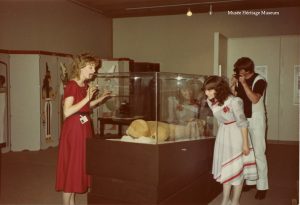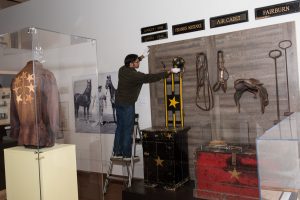Then & Now
Musée Héritage Museum
October, 2016

Image credit: Musée Héritage Museum
St. Albert has always been a community that’s taken its heritage seriously, and with good reason. We live in one of the oldest, permanent settlements in Alberta, and the stories of our founders are nothing less than awe-inspiring. Though we don’t often consider it, those stories and our history do not maintain themselves. And the ease with which we access the past here in St. Albert is due largely to over 30 years of hard work on the part of the Musée Héritage Museum. Ever wondered how this great public resource came to be? You’re in luck.
1980s
Prior to 1984, the majority of St. Albert’s historical artifacts were housed in residential basements, where they didn’t do much more than gather dust. Pioneer artifacts were on display at the Father Lacombe Chapel, but not much else.
In 1984, along the banks of the Sturgeon River, St. Albert Place was constructed to serve not only as a new city hall but also as a home to the arts. It was built with Musée Héritage Museum in mind, providing rooms for rotating exhibits, permanent displays and a large, publically accessible archive. Though St. Albert has always had historic sites scattered around the city, the opening of the Musée Héritage Museum meant that the city would now have a dedicated hub for historical education and research.
Those first few years were largely dedicated to the gathering of artifacts, which would be studied and publicly exhibited. In 1989, the City of St. Albert acquired possession of the Little White School and gave it to the historians of the museum to maintain—their first artifact that wouldn’t quite fit into the archives.

1990s
As the collections of the museum continued to grow, so too did its external holdings. In 1991, the St. Albert grain elevators were acquired by the city and given to the museum as a means to both preserve and develop them. Unlike the Little White School, however, the city’s grain elevators were not safe for members of the public to enter. Though they wouldn’t be open to the public for some time, the elevators were at least safe under the care of the museum.
Since its opening, the museum had been operated by a department of the city called the Museum Management Board. In the mid 90s, however, the board was disbanded, and control of the museum was given to a new organization called the Arts and Heritage Foundation of St. Albert, the organization that still manages the museum today.
2000s
The early 2000s saw the Musée Héritage Museum making some serious plans for the future. There was always an ongoing policy of growing the collections, but in the new millennium, the museum set its eyes on restoration. Plans were drawn up to return the schoolhouse and grain elevators to their original majesty, and work began on digitizing many of the documents housed in the archives—a task which continues to this day.
In 2006, the grain elevators were deemed safe for public entry, though only for pre–arranged events. At that same time, initial plans were drawn up to turn the land around the grain elevators, an area known as River Lot 23 and 24, into an interpretive site. The historic Chevigny House was transported to Lot 24 in 2008, where it waits for the rest of the infrastructure of the River Lots to join it.
2010s
Restoration on the St. Albert Grain Elevators was completed in 2011, and today, daily tours are offered during the summer months. The Little White School’s restoration work was completed soon after in 2012, ensuring that it would remain publicly accessible in the years to come. Development on the two river lots continues today, and one day soon the residents of St. Albert will be able to see daily life as it existed on the farms of our city’s Metis founders.
As for the Musée Héritage Museum itself, the archives, as always, continue to grow. t8n
Fun Fact
According to the latest count, the Musée Héritage Museum is home to 6500 artifacts, 3000 pre-war photographs and over 70 metres of written documents.
Did You Know?
Although the city retains ownership over the museum’s historic resources, the Arts and Heritage Foundation is responsible for managing the collections and bringing historical education to the public.













